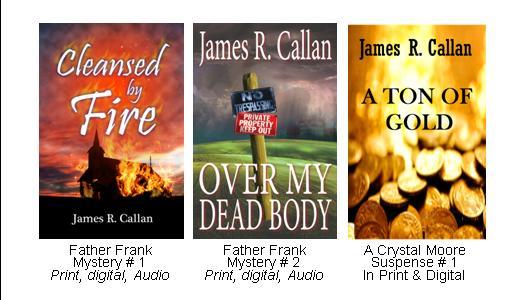James R. Callan's Blog, page 12
March 23, 2017
Talented and prolific writer Jim Ainsworth has a book lau...
Talented and prolific writer Jim Ainsworth has a book launch of two books at the same time. (I said he was prolific.) It will be from 5 to 8 p.m. March 28 at the A&M-Commerce (Texas) Alumni Center. Because it is unusual to do two books at once, I’ve asked Jim to tell us the story behind the covers of the two books. Very interesting.
Circle of Hurt – We worked diligently to come up with real photos that matched my description of the general store, the table and chairs, the ambiance of the place, but we just could not make it work. I decided a shack might work, with wooden boards as the background.
The real picker shack was clearly in my mind, but it is long gone. My wife, Jan, suggested we drive around and look at cabins, shacks. As we drove by my cousin Marion’s cabin, Jan pulled over.
“What about that one?”
“That cabin is only a few years old. The picker shack would have been maybe a hundred years old when the novel takes place.”
Jan smiled. “Yes, but wasn’t this one built to look old?”
She was right. Marion’s cabin was a cross between the picker shack in the book and Tee Jessup’s rented farmhouse. It could serve as either. And Marion would be pleased.
Sure enough, the table where we had weekly poker games looked ready for players. I realized that this setting, the old jukebox and a few other things might have partially inspired the scenes inside the general store described in the book.
After what seemed dozens of shots, I turned and saw Jan with her camera inches from the wall, snapping more photos.
I was puzzled. “What are you doing?”
She kept on clicking. “You said you wanted boards for the background, didn’t you?”
Days later, she showed me her concept, saying, “I feel as if I’m on the inside of the cozy cabin stealing a look at the story that is taking place outside.” That worked for me.
She and Vivian Freeman got together on the concept and colors and the rope and that’s how the cover of Circle of Hurt came to be.
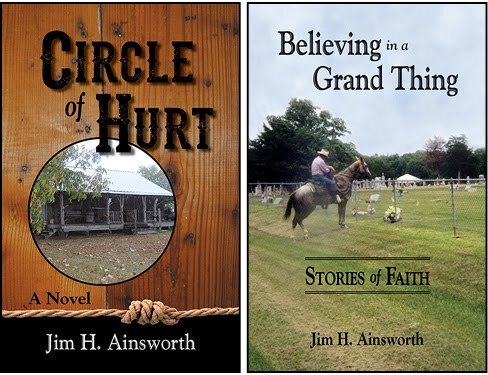
Believing in a Grand Thing – My original idea for the cover was a cowboy or western scene on the front—maybe a kneeling cowboy with a cross in the background. But we see of lot of those in yards all around. We tried a few photos in public domain, but the lights just did not come on for me.
Something about the way the cowboys (or models) sat their horses; or the way they put their boots in the stirrups; or the way they held the reins; or the way they wore their hats always bothered me. Something just wasn’t right and I couldn’t express what.
Again, my wife Jan came through. “Do you still have that shot of Marion on his horse at his daddy’s grave?” Marion was a close cousin of mine.
The photo was taken on the next to last day of our wagon and horseback trip across Texas that I chronicled in Biscuits Across the Brazos. We were almost home, coming to the end of our fourteen day, 325 mile journey when it was taken.
I saw Marion lope ahead as we neared Shiloh Cemetery and knew where he was going. When he stopped at his father’s grave, I pulled a throwaway camera I had bought on the trail out of my saddlebags and took the shot. I knew it was a special moment, but never imagined it would one day be on the cover of a book. Of course, it is also inside Biscuits Across the Brazos.
If you look closely, you will see a slight hazy glow around Marion and his horse’s back legs. Unintended, but I like that a lot. I am certain Marion would, too.
Marion’s mom now lies beside his father and Marion is laid to rest a few feet away.
Try to visit the launch party. There you can ask Jim Ainsworth questions about the books, the covers, or anything, for that matter. I highly recommend it as a pleasant, fun, informative trip.
March 17, 2017
When Someone Walks Through Your Door
A few years ago, my wife and I were in Oklahoma to remodel a house we owned on some acreage. Much work needed to be done. There was an enormous  room that could be converted into two good sized bedrooms. We needed to remodel one of the bathrooms and completely redo the kitchen – new cabinets, new hot water heater, and on and on.
room that could be converted into two good sized bedrooms. We needed to remodel one of the bathrooms and completely redo the kitchen – new cabinets, new hot water heater, and on and on.
The house is in a thinly populated area, with few close neighbors. We were quite surprised one day when a man walked into the house and started watching our efforts. He made suggestions on how we might accomplish a task more easily.
After awhile, he asked, “Are you staying here at night?”
It was clear no one was staying in this house at night. There was no furniture, and it was certainly not fit for sleeping. I said, no, we were staying in a nearby motel.
He looked around at our tools and asked, “Do you leave your tools here at night?”
This gave me pause. Why did he want to know about our tools? Finally I said we locked the place up when we left, trying to make it sound like it was secure. It wasn’t all that secure.
He acknowledged my statement, turned around and disappeared.
 We didn’t know what to think. We had come from Texas in a small Ranger pickup. Space didn’t allow for many tools, and certainly nothing large. Still, there were several power tools that would be a little expensive to replace.
We didn’t know what to think. We had come from Texas in a small Ranger pickup. Space didn’t allow for many tools, and certainly nothing large. Still, there were several power tools that would be a little expensive to replace.
About thirty minutes later, the man walked in again. “My name is Gary. If you will really lock things up tight, I’ve got some power tools that will make your job easier.” He produced a nail gun with various attachments for heavy work or trim work. He offered other tools to make the installation of door hardware easier, faster, and more professionally done.
He said he wouldn’t always be around to either deliver or take back the tools, so he would leave them in my care.
Over the next few weeks, he popped in frequently, always with some sound advice, usually with other tools. And when we were ready to paint the outside, he provided a professional paint sprayer and hoses.
Now, years later, we are still good friends with Gary.
In m y newest novel, A Silver Medallion, a young Mexican walks into Crystal Moore’s life, as unexpected as Gary was to us. But in my novel, it is the young woman who needs help. She has been a slave in modern day Texas, held, not by chains, but by threats to kill her husband still in Mexico. By accident, she learns her husband has died, so she escapes. She tells Crystal of another woman held slave by threats to kill her two children left in Mexico.
Crystal lost her parents when she was seven. She identifies with the plight of the two young girls in Mexico, held captive, not knowing if their mother was alive or not. Crystal knows the woman will never escape as long as her children are held hostage.
The only way to free the mother is to first rescue the children. Crystal tries to put this out of her mind. It is not her problem. But her conscience will not allow that. After many sleepless nights, Crystal realizes she must travel to Mexico and try to rescue the girls. Only then can she help the mother escape.
When someone walks into your life, you will be affected, one way or another. Expect it. Make the most of it. It is usually easier to ignore the person. But look on it as an opportunity. It could be an important one.
James R. Callan, 2017
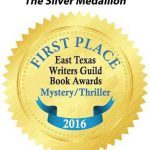
March 10, 2017
The Joy of Creating Characters
Jean Lauzier loves to play in all the different genres, but especially mystery and fantasy.
but especially mystery and fantasy.
She is a member of several writer’s groups and president of the East Texas Writer’s Association. When not writing,
she enjoys reading, trying to grow bonsai trees, training dogs, editing, and mentoring other writers.
“Fictional characters are made of words, not flesh; they do not have free will, they do not exercise volition. They are easily born, and as easily killed off.” ― John Banville
I’m not sure who John Banville is, but I have to disagree. At least for myself. I have one of those obsessive personalities and when I’m writing, I live and breathe my characters. I think about their likes and dislikes, how their past affects their present, and just what they want out of life.
Sometimes, I even forget they aren’t real. For example, one day while in the middle of a writing session, a song came on the radio and I realized Cande would have listened to and liked that song. Now, Cande is a character in a mystery novel I’m editing, but we’re also best friends. I know about the time she tried to paint her pony black  because she wanted to go as the headless horseman for Halloween. I know how she defends those being bullied, her soft spot for animals, and how much she loves settling in front of a fire with a cup of hot cocoa. She’s a person I’d really like to hang out with.
because she wanted to go as the headless horseman for Halloween. I know how she defends those being bullied, her soft spot for animals, and how much she loves settling in front of a fire with a cup of hot cocoa. She’s a person I’d really like to hang out with.
I also know that as her writer, I can’t get her to do something against her nature. At the end of the novel, I really wanted her to take justice in her own hands and off the bad guy. But that’s not her. Yes, she’s an emotional wreck because of what she thinks he has done, but she believes in doing the right thing, even when it’s hard. And that is one of the things I love about her.
 Another thing I love is when a character just appears and refuses to disappear. While writing Dragons of Jade, I was typing along in the groove, and a dog appeared in a scene. I didn’t want a dog in the book so backspaced and deleted him. A few sentences later, my character opened the door and in bounded the dog. He had a name, a personality, and I knew exactly what he looked like. I thought about deleting him again but just couldn’t. Turns out, he was an important part of the story.
Another thing I love is when a character just appears and refuses to disappear. While writing Dragons of Jade, I was typing along in the groove, and a dog appeared in a scene. I didn’t want a dog in the book so backspaced and deleted him. A few sentences later, my character opened the door and in bounded the dog. He had a name, a personality, and I knew exactly what he looked like. I thought about deleting him again but just couldn’t. Turns out, he was an important part of the story.
Some authors seem to have no problem killing their characters. I read the Game of Thrones series and every time I became attached to a character, they turned up dead. I’d be a blubbering puddle of tears if I killed off as many characters as he has.
Once I read we need to get our characters up trees and then throw rocks at them while setting the tree on fire. I have a hard time doing that, especially with characters I love. I want things to go right for them. I want them to succeed and be happy. It’s something my editor says I need to work on. And, I am trying.
Creating characters is one of the fun things about being a writer. I learn about t heir jobs, their culture, and just what makes them tick. Then, we hang out in front of the fireplace sipping hot cocoa and telling stories.
heir jobs, their culture, and just what makes them tick. Then, we hang out in front of the fireplace sipping hot cocoa and telling stories.
You can find more about Jean on her Facebook page – https://www.facebook.com/jeanlauzier2319
All her books are available on Amazon or can be ordered from any bookstore.
March 3, 2017
Mailboxes and Murals
A few years ago, we traveled to Tasmania. It was for us like finding a beautiful gemstone while playing in the sand.
It is an island roughly the size of West Virginia located about one hundred  fifty miles across the Bass Strait from Melbourne, Australia. It was discovered in 1642 by a Dutchman named Abel Tasman, but there were a number of Aboriginal tribes there when the British came to settle it in the late 1700s. At the time we were there, the population was just over half a million people.
fifty miles across the Bass Strait from Melbourne, Australia. It was discovered in 1642 by a Dutchman named Abel Tasman, but there were a number of Aboriginal tribes there when the British came to settle it in the late 1700s. At the time we were there, the population was just over half a million people.
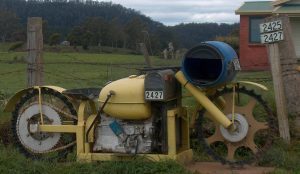 Until recently, fully one third of the island was in a protected forest, with no roads, no villages to disturb the natural beauty. In the last couple of years, some timber companies have been allowed into this area (a mistake in my opinion).
Until recently, fully one third of the island was in a protected forest, with no roads, no villages to disturb the natural beauty. In the last couple of years, some timber companies have been allowed into this area (a mistake in my opinion).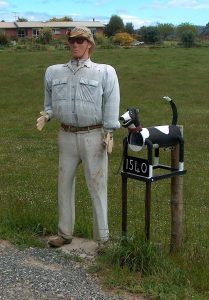
One day we set out to drive across the middle of Tasmania. We observed some rather interesting mail boxes. Upon asking some questions in the first village we came into, we learned that the people who lived along this highway had a friendly competition to see who could come up with the most unique mail boxes.
Some of these were extremely elaborate, many very clever, all attention-grabbing And throughout the day, we continued to find such out-of-the-ordinary ways to receive mail.
In the midst of this, we came upon the town of Sheffield, often called Tasmania’s Outdoor Art Gallery. If we found a building with an exposed side wall, we would find a mural. The first mural in Sheffield was commissioned in 1986. Many of the pictures give aspects of the history of the town and Tas. We could not count all of the murals, but there must have been close to a hundred walls colorfully decorated.
the midst of this, we came upon the town of Sheffield, often called Tasmania’s Outdoor Art Gallery. If we found a building with an exposed side wall, we would find a mural. The first mural in Sheffield was commissioned in 1986. Many of the pictures give aspects of the history of the town and Tas. We could not count all of the murals, but there must have been close to a hundred walls colorfully decorated.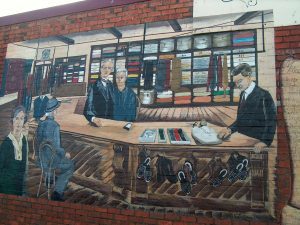 Keep in mind that Sheffield is a small town of approximately 1,400 people. However, it has become a major tourist attraction, with an estimated 200,000 visitors each year.
Keep in mind that Sheffield is a small town of approximately 1,400 people. However, it has become a major tourist attraction, with an estimated 200,000 visitors each year.
But Sheffield and the mailboxes are not the only things to see and be amazed over in the middle of Tasmania. In another blog, I’ll talk about the incredible wall being  carved and the amazing use of hydro electric generation in Tasmania. Oh, and we must not forget the Tasmania Devils, the only thing we knew about the island (thanks mostly to Walt Disney)before we visited it.
carved and the amazing use of hydro electric generation in Tasmania. Oh, and we must not forget the Tasmania Devils, the only thing we knew about the island (thanks mostly to Walt Disney)before we visited it.
Feel free to add your comment about interesting things you’ve seen on your travels. Thanks.
James R. Callan
In print & e-book format
February 24, 2017
Road Trip to Main
Today’s guest bloggers are the Cuffe Sisters, Sadie and Sophie.  They were born, raised, and still live in the rugged area known as the Unorganized Territory in Main. They maintain a small farm, but (we know) their main goal is to produce great novels. They write “squarely to the hearts of real women who don’t always wear a size two and who prefer boots to high heels. And they believe some of the best stories are composed on the seat of a tractor. They will give a free copy of their latest book to a name drawn at random from those who leave a comment. Here are the Cuffe Sisters.
They were born, raised, and still live in the rugged area known as the Unorganized Territory in Main. They maintain a small farm, but (we know) their main goal is to produce great novels. They write “squarely to the hearts of real women who don’t always wear a size two and who prefer boots to high heels. And they believe some of the best stories are composed on the seat of a tractor. They will give a free copy of their latest book to a name drawn at random from those who leave a comment. Here are the Cuffe Sisters.
We grew up on road trips. After traveling around the State of Maine, we later branched out to cross-country travel, vising relatives in California. It’s 3240 miles (give or take) from here to there. We traveled in a VW bus and camped out along the way. Six people in an old canvas Army tent was an adventure in itself, LOL. At the time, one of our cousins pointed out that we’d now stuck our toes in both major oceans. Some people haven’t experienced either one. Funny, the things you take for granted.
We grew up on the coast and now live Down East – where the sun first strikes the easternmost point of the USA.
Throughout the years we’ve hiked and biked around many islands. To date we’ve visited about twenty, but that’s nothing considering there are over 6180 left to explore. Some are easily accessed by huge bridges (one of Sophie’s biggest dreads), others by ferry, some by private boat. We rode the mail boat on our first trip to Isle au Haut many years ago, and asked the captain if we could go out on the deck. It was choppy, but he let us. As soon as we stepped out, a huge wave slapped the bow and covered us in spray. We went back into the cabin, soaked, but laughing like fools. It was wicked fun!
 We experienced ten seconds of fame once, when photographers from Down East Magazine took a picture of us roasting hotdogs at our island campsite. When we finally found the article, months later, we were surprised at the caption: Local campers cooking over an open fire. Even WE didn’t recognize ourselves!
We experienced ten seconds of fame once, when photographers from Down East Magazine took a picture of us roasting hotdogs at our island campsite. When we finally found the article, months later, we were surprised at the caption: Local campers cooking over an open fire. Even WE didn’t recognize ourselves!
Our coastline, as the crow flies is, 250 miles, but the reality is vast – it’s over 5500 miles when all the islands are included. Islands hold a precious place in our hearts, but they’re more than our memories and adventures. They hold their own special mystique in their fiercely loyal people, their rugged independence, and their wild solitude. We hope our love of Maine and its islands comes through in our newest book, Blind Man’s Bluff, A Candle Island Cozy. 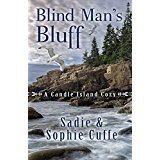 Come to Candle Island, hear the lonely cry of the gulls, feel the spray of the raging surf, and plant your feet on the bedrock ledges of Maine that have endured for millenia. We’re giving away a copy, so if you’d like to be entered in the drawing, all you have to do is leave a comment. Good luck, and thank you, Jim, for letting us visit!
Come to Candle Island, hear the lonely cry of the gulls, feel the spray of the raging surf, and plant your feet on the bedrock ledges of Maine that have endured for millenia. We’re giving away a copy, so if you’d like to be entered in the drawing, all you have to do is leave a comment. Good luck, and thank you, Jim, for letting us visit!
JIM: Makes me want to visit Maine again. Please leave a comment and the Cuffe Sisters will draw a name and send the winner a FREE copy of their latest novel. Thanks.
February 17, 2017
A NaNoWriMo Education
Galand Nuchols is a retired school teacher. While teaching,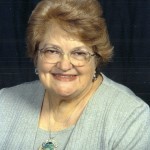 she found that writing short stories that incorporated the names of students helped to improve their interest and motivated them to work harder. At the same time, she found she really liked to write. Once she retired, she dove into writing full time and has turned out a number of books that are not only aimed at young teens, but can actually be a great help to them, particularly boys. This year, she took on another challenge. And today, she tells us about it.
she found that writing short stories that incorporated the names of students helped to improve their interest and motivated them to work harder. At the same time, she found she really liked to write. Once she retired, she dove into writing full time and has turned out a number of books that are not only aimed at young teens, but can actually be a great help to them, particularly boys. This year, she took on another challenge. And today, she tells us about it.
For the least two years I’ve heard about the challenges and difficulties of the NANOWRIMO (National Novel Writing Month) contest. There were a few pros and a lot of cons coming from former participants. So why did it keep tap, tap, tapping at my brain? Why would I even consider giving up an entire month, especially the month of November with all the Thanksgiving and Christmas preparations: decorating, parties, family gatherings, travel, etc. to write 50,000 words in thirty days? For some unexplained reason I chose to do just that, and I learned a lot from the experience.
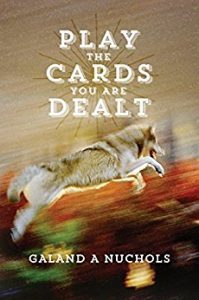 Plan ahead is at the top of the to-do list. I knew going in that I had to type an average of 1667 words every day. I realized I would not have the luxury of doing research as the story progressed from scene to scene. I spent hours talking to councilors, nurses, and on the internet collecting information on depression, appendicitis symptoms, the Big Thicket, suicide attitudes, guilt and anything else that I might possibly need, then recording it in a handy file.
Plan ahead is at the top of the to-do list. I knew going in that I had to type an average of 1667 words every day. I realized I would not have the luxury of doing research as the story progressed from scene to scene. I spent hours talking to councilors, nurses, and on the internet collecting information on depression, appendicitis symptoms, the Big Thicket, suicide attitudes, guilt and anything else that I might possibly need, then recording it in a handy file.
Some of my characters were from a previous novel, but I had several new characters and prepared a physical description of each as well as their mental state. That left me time to create a couple of new characters I had not anticipated needing.
There would be several different sites in the novel. I toured the site where my characters would be living and traveling, took pictures of homes, barns, roads, and foliage in the area. A hospital would be needed. Descriptions of the entrance and waiting area of the local hospital were recorded for quick recovery. The highway the characters would be traveling on when they got lost was marked on a map so the proper towns could be named and included. Words counted and I would need all the names and descriptions of people and places I could work in.
A general outline of events that would happen in each chapter was worked out. None of my previous novels had over 25,000 words. I knew I would have to try something different and took a leaf from my favorite author’s writing style. Elizabeth Moon often moves from one character’s point of view to another’s point of view by starting a new chapter. This allows the author to let the reader see more details of the story, and it uses up more words. I decided ahead of time whose point of view and what event would be used in each chapter. This one feature helped me with the ‘head hopping’ errors I made in previous novels, errors my friends noted in their editing of my work.
All this was done before November 1. As it turned out, I still ran out of story before I used up 30,000 words let alone the required 50,000 needed to complete the contest. I had to carry the story of the suicide character on for another twenty thousand words or more. These extra events took time to develop, time I would not have had without the research and recording of information for the first chapters.
When we are faced with a deadline, we often give ourselves a kick in the pants and push on. I found this to be the case when I was tired or undecided on the next paragraph and tempted to stop at 500 words and go to bed or clean house or address Christmas cards. Then the thought of having to type over 2834 words the next day spurred me on to type something, even knowing it would have to be reworded. The idea was to get the story written and polish it later. It didn’t matter that I’d used the word ‘frowned’ fifteen times in the chapter. I pressed on with the idea of using a thesaurus during the cleanup phase after the close of the contest.
When last of those 50,000 words were typed, the story roughed in, and the submit button pushed, the satisfaction of knowing ‘I did it’ was great. The job was done, maybe not well done but done just the same. And best of all, I learned several things in the writing process.
JIM: Thanks, Galand,for enlightening us, and encouraging us. We can all use it. Readers, click here to find more about Galand and her work.
February 10, 2017
Mixing History with A Fiction Novel
Elaine Faber is a member of Sisters in Crime, Inspire Christian  Writers, and Cat Writers Association. She lives in Northern California with her husband and three housecats. She volunteers at the American Cancer Society Discovery Shop in Elk Grove, CA.
Writers, and Cat Writers Association. She lives in Northern California with her husband and three housecats. She volunteers at the American Cancer Society Discovery Shop in Elk Grove, CA.
Elaine has written poetry and short stories since childhood. She has completed six novels. Multiple short stories are published in magazines, on-line weekly magazines and in thirteen short story collections (anthologies). She writes cozy mysteries and humorous mysteries.
Today, she talks about mixing history into fiction novels.
Great care must be taken when mixing fiction with historical events. An author must never change history, but where’s the harm in tossing your character into the action with our plots? Example: Imagine if your fictional character lived next door to Benjamin Franklin and loaned him a kite one stormy night? Or during the Revolutionary War, your character sold his horse to Paul Revere. Our imaginary character doesn’t discover electricity, nor warn of imminent British attack, but the kite and the horse came from somewhere, right? I’m being sarcastic, of course, but you get the idea. It’s called literary license
My latest WWII era humorous mystery/adventure, Mrs. Odboddy – Undercover Courier is hot off the press this week. Mrs. Odboddy, an eccentric elderly woman fights the war from the home front. She is determined to thwart conspiracies and expose Nazi spies and in her bumbling way, does a pretty good job of it.
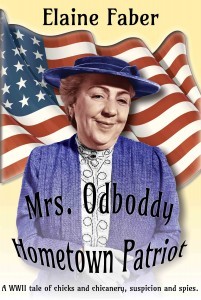 In Mrs. Odboddy Hometown Patriot, Agnes spots a Japanese air balloon bomb while manning a watch tower on the beach. She uncovers a ration book conspiracy and becomes romantically involved with an FBI agent searching for missing Hawaiian funds. And she meets Mrs. Roosevelt. As she weaves through historical facts, she changes nothing. Who’s to say it couldn’t happen that way?
In Mrs. Odboddy Hometown Patriot, Agnes spots a Japanese air balloon bomb while manning a watch tower on the beach. She uncovers a ration book conspiracy and becomes romantically involved with an FBI agent searching for missing Hawaiian funds. And she meets Mrs. Roosevelt. As she weaves through historical facts, she changes nothing. Who’s to say it couldn’t happen that way?
In the just published sequel, Mrs. Odboddy, Undercover Courier, Agnes travels by train to Washington DC to join Mrs. Roosevelt on her Pacific Island tour. Agnes is asked to hand-carry a package to President Roosevelt. They must be secret war document! (Could happen!) She expects Nazi agents to attempt to steal her package. (It’s possible.) Of course, along the way, she also meets some intriguing characters who hinder as well as aid her in her mission.
Agnes befriends David and Samuel, two black soldiers bound for the Tuskegee Air Base, where they will be trained with the first all-Black fighting pilot squadron. And here is a bit of history about the Tuskegee soldiers.
Due to the many black men who wanted to volunteer, and the extreme loss of pilots in battle, it became expedient to set up a program to train Black fighter pilots, bombardiers and air support staff. A number of Black men with higher education and pre-war flying experience were selected to train as fighter pilots, but in a segregated squadron.
The most successful all Black squadron was the 99th squadron. They began to fly bombing missions in the spring of 1943.
Nine hundred ninety two Black pilots were trained in Tuskegee from 1941-1946. They were credited with 1578 combat missions, 179 bomber escort missions, destroyed 112 enemy aircraft in the air, and another 150 on the ground. Nine hundred fifty rail cars tracks and motor vehicles were destroyed. One destroyer was put out of action. Forty boats and barges were destroyed. Multiple citations were awarded along with many silver, bronze, air medals and 8 purple hearts.
Segregation of the troops ended in 1945.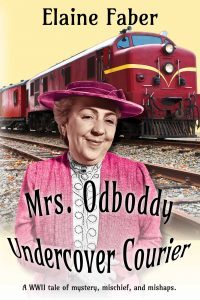
When Agnes finally gets to Washington to complete her mission, she faces trials that challenge her perception as a home front warrior and the scourge of the underworld. Mrs. Odboddy – Undercover Courier will amaze and amuse all the way from California to Washington, D.C.
Available at Amazon for $3.99 (e-book).
Elaine’s website is: http://www.mindcandymysteries.com
Email your questions or comments to Elaine.Faber@mindcandymysteries.com or leave a comment here. Thanks.
February 3, 2017
Been Stung By Tate Publishing? Me too.
Here’s a post from Gay Ingram that will be of interest to anyone who has  published or is planning on publishing with Tate Publishing.
published or is planning on publishing with Tate Publishing. 
Recent events in the publishing industry have affected many authors I know in my area, including myself. Back in 2007 and upon the recommendation of a client, I submitted my manuscript about the years of my husband’s depression, Living with a Depressed Spouse, to what advertised themselves as a ‘traditional publisher.’ The fact that they advertised themselves as a ‘Christian Publishing House’ influenced me. When I received a personal letter from the publishing company’s president, I overcame my resistance and signed the contract.
I was a newbie and not very knowledgeable about the publishing process. The contract I received from the publishing house, Tate Publishing based in Mustang, Okla., stipulated a substantial amount required from the author as a ‘financial investment.’ After a certain number of copies were sold, this money would be returned to the author.
Over the years, my book continued to sell in minute quantities and I received correspondence from Tate representatives on a regular basis. I also received numerous offers of marketing/promotional opportunities, all available for a fee.
One week last month, Tate sent an email inviting me to participate in yet another marketing venture. The next week, an email from them contained a form advising me that the company was closing its doors and I had the opportunity to purchase back my manuscript file, if I so desired…for $50.00. I would expect no refund or monetary compensation if I signed this form.
My response was to ignore the offer and dig out my ten-year-old contract, hoping to read that their actions constituted a breach of contract. To the web I turned, looking for more information and advice. I found two reliable sites detailing the downward track of Tate Publishing. The third site posts comments from authors who have been dealt badly by Tate Publishing. One of these sites mentions documentation of Tate executives re-organizing under the name of Lux Creative Concepts, LLC.
https://www.consumeraffairs.com/misc/tate_publishing.html
I’ve not found any evidence of a class action suit being instigated and would love to have that information if anyone has it. In the meantime, I will have to file this as a major learning experience.
If you have had any dealings with Tate Publishing, Please leave a comment.. Thank you.
January 27, 2017
Why & How Your Should Appreciate Poetry
Skip Hughes is a poet. Yes, he’s done many other things, including teaching in college. But at the core, he is a poet. And today, he would like to encourage you to consider poetry for the pleasure it can give you.
teaching in college. But at the core, he is a poet. And today, he would like to encourage you to consider poetry for the pleasure it can give you.
Of Poetry
Please forgive me, gentle reader, for I’ve yet to catch up with a most modern phenomenon, so this guest blog is an experiment -my very first blog post.
Do you like poetry? I hope you do, but if you don’t please permit me to persuade you toward enjoying poetry.
I. Poetry as spoken is the use of spoken language in story-telling or song, by conjecture among the most ancient uses of all spoken language, a phenomenon whose origin is lost in the distant mists of time.
II. Poetry as written is the earliest known form of western literature, recorded from c.800 B.C. (See Homer.) It was the only known form of western literature through c.460 B.C. (See Herodotus, Plato, et al.) As composed of alphabetic letters used to form words, it is the earliest known form of any literature. (See Oriental Languages.)
III. Poetry as performed. According to Aristotle (See the Poetics.) and as well by conjecture, audiences of sung poetry (See Greek Theatre.) experienced a sort of catharsis, an influence toward the civilizing of their thoughts and behavior. Accordingly, as performed either without or with music, i.e., as song, poetry ought to be powerfully evocative, easily commanding an audience’s attention.
IV. Poetry as Read.
Read a poem with care. Be prepared to laugh or cry, or both at once. Read a poem for the joy of it, sometimes for the sadness. Read a poem many times, and even memorize it. Keep on reading a poem only if does bring you joy or worthwhile sorrow, e.g., as treasured memory.
Read a poem for more than one meaning, and on more than one level, etc. emotional and intellectual. Also a poem may have one obvious interpretation, and another not so obvious that sneaks up on the reader.
Read a poem aloud, to somebody else or just to yourself. Listen to the sounds you’re hearing as you understand the words. That sound is an essential aspect of poetry.
Read poetry in small bites. Allow thinking time between poems. Never permit yourself to become less attentive by trying to read too much poetry at one occasion.
V. A poem to read.
Campfire Musings
by Skip Hughes
As yonder in the western sky, the last
Of bustling daylight dims, as father night
Shrugs on his fine black mantle, campfire light
Bewitches me, its artful spells to cast.
Where then companions, friends of years long past,
But in those ghostly shadows, tricking sight
Beyond the campfire round? They seem so slight,
Those wraithlike phantoms, forms of darkness vast.
The fire now flickers low, its embers faint,
Pale, ash-bound. Ghosts have fled, gone who knows where,
And sleep with spectral finger beckons me.
But day will come I trust, and reacquaint
Me once again with life, with light and air,
Another chance to live reality.
©2017 Floyd E. “Skip” Hughes
I quite attempt to write my poems to these standards, and some of them have indeed been published in a variety of anthologies and periodicals. I wrote “Campfire Musings” for my next book, since the content of my recently published one has been set for several years. My existing book, entitled 
is available on Amazon. Click here to take a look.
And leave us a comment on how you relate to poetry – like it, don’t like it, never read it, whatever. Thanks.
January 20, 2017
The Hard Work of Telling the Truth:
D.R. Ransdell is a writer and musician. She spent five years in Mexico  teaching English and learning folk songs. Now, she plays with a mariachi group and writes a murder mystery series about mariachi bandleader Andy Veracruz. She also teaches writing at the University of Arizona. Here’s her take on The Hard Work of Telling the Truth: Moving from Fiction to Non-Fiction.
teaching English and learning folk songs. Now, she plays with a mariachi group and writes a murder mystery series about mariachi bandleader Andy Veracruz. She also teaches writing at the University of Arizona. Here’s her take on The Hard Work of Telling the Truth: Moving from Fiction to Non-Fiction.
At Bouchercon last September, Catriona McPherson explained that she had graduated with high honors from the University of MSU—Make Stuff Up. Evidently I was a classmate! I too love to make stuff up. As an only child until I was nine, I was forced to create my own worlds. I remember running around the basement with my little sheriff badge and gun holster while chasing bad guys, and flapping my arms while pretending I was Peter Pan. When I’m writing, I love to create scenes, invent dialogues—design my fictional world according to my preferences. Hence when I took on the challenge of writing non-fiction, the task was monumental!
 For years I’ve played mariachi music. Experiences in the band led me to create Andy Veracruz, a mariachi violinist who stars in his own mystery series. But when I tried to write about my true-life experiences, I stumbled.
For years I’ve played mariachi music. Experiences in the band led me to create Andy Veracruz, a mariachi violinist who stars in his own mystery series. But when I tried to write about my true-life experiences, I stumbled.
At first I suffered simple resistance. A friend kept saying, “You should write all this stuff down.” She was enthralled with my stories of mariachi gigs gone bad, bad mariachi players, bad guest singers—the kinds of normal experiences you have when playing five nights a week in a folk music group. Every few months Cookie would ask if I’d started writing yet. Then one day I was inspired after hearing Gioia De Cari talk about her experiences as one of the few females in M.I.T.’s graduate math program. As I left the theatre I knew two things: I was awfully glad I hadn’t studied math, and I needed to find a way to share my musical 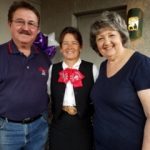 adventures.
adventures.
That night I started writing. Cookie had told me to write everything down—and I did! Big mistake. After eight months of hard work, I’d written 112,000 words! That was only a first draft, so I honed it down, and the result was a mere 105,000. Not bad for years of mariachi playing, right? After two more drafts, I passed off the results to two trusted beta readers.
They told me the manuscript was boring. Gilbert Velez, D.R. & Cookie
Ouch.
My biggest mistake? I tried to stick to the facts. I recorded the events in chronological order and included every detail. I was true to my experience! But that was much too much for any reader besides Cookie.
For a long time I was at a standstill. I was caught in hyperspace between the total fiction I was used to writing and the absolute truth I had drafted. And so the manuscript sat. And sat. Two summers later I was in Italy writing a travel piece when I realized: Oh. You tell the truth, kinda sorta. You write with the reader in mind, not the writer. You throw away details. You forget about “real time.” Instead you concentrate on cohesion so that the stories make sense in relationship to one another.
A Herculean task. It took me another three versions to get close to right, but this time my beta readers agreed: The manuscript was fun. It flowed. The stories were complete within themselves. Thus I had made big progress. But I still hadn’t finished. My beta readers complained that here and there I had been harsh—very harsh—about things I was still mad about. Those flashes of anger made me seem shallow without improving the memoir as a whole. Painfully I removed or softened those sections. I’m still mad about some recent events, but holding onto anger won’t change the past or help the future, so why dwell on negativity?
 Now that Secrets of a Mariachi Violinist has been published, I’m delighted to return to a fictional world where I’m in control of every action, setting, and thought. Eventually my dance with non-fiction will continue with more travel pieces, but for the moment I feel right at home. I’m back at MSU where anything can and does happen just the way I want it to!
Now that Secrets of a Mariachi Violinist has been published, I’m delighted to return to a fictional world where I’m in control of every action, setting, and thought. Eventually my dance with non-fiction will continue with more travel pieces, but for the moment I feel right at home. I’m back at MSU where anything can and does happen just the way I want it to!
What have been your own experiences going back and forth from fiction to non-fiction? Which do you find easier? Which kind of writing do you prefer and why?
Leave a comment, even if you don’t play in a Mariachi band. Thanks.
For more details, please visit: http://www.dr-ransdell.com

